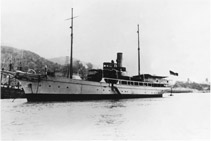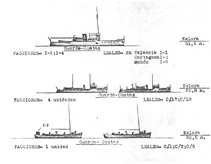When the northern front fell, the majority of the members of the Basque Auxiliary Navy managed to make it to French ports. Just over half of these sailors would remain permanently in France. The others would cross the Catalan frontier and continue the war in the Republican ranks. Over half of them would join the Republican Navy and others would go into the Army and in the DCA (Air Defence). Another group, which other former members of the Basque Merchant Navy joined, remained in Catalonia without a posting. In April 1938, Franco’s troops reached the Mediterranean through Vinaroz. This cut the Republican territory in two and isolated Catalonia from the rest of the loyal territory. The idea then emerged to organize a maritime service that would provide a link between the two zones and transfer personnel, official correspondence and some supplies from one to another. The Basque sailors with no posting would join this service. The idea was rapidly accepted by Commander Juan Víctor Echevarría, political commissar of the Carabineers General Directorate, which entrusted his post in practice to the Central Transport Headquarters of the Ministry of The Treasury and Economics.
 The Basque sailors would join the Carabineers Corps and they became the crew of a small flotilla consisting of the yacht Nere Ametza (359 tn.); various surveillance motor boats belonging to Tabacalera, the largest one was the I-1 (128 tn.); a few motor sailboats between 100 to 300 tons and barely any speed, and some motor boats and yachts used for surveillance and port services. Some boats were armed with one or two machine guns to defend themselves from air raids, but other were not armed. They were all assigned a numeral preceded with the abbreviations M.H.F. (“Ministerio de Hacienda-Flota”=Ministry of the Treasury-Fleet). The main bases were in Barcelona, headquarters of the Central Transport Headquarters, and Valencia, seat of the Deputy Headquarters. There were also only posts in other coastal towns and there were also barracks for the carabineers not embarked in Premiá de Mar.
The Basque sailors would join the Carabineers Corps and they became the crew of a small flotilla consisting of the yacht Nere Ametza (359 tn.); various surveillance motor boats belonging to Tabacalera, the largest one was the I-1 (128 tn.); a few motor sailboats between 100 to 300 tons and barely any speed, and some motor boats and yachts used for surveillance and port services. Some boats were armed with one or two machine guns to defend themselves from air raids, but other were not armed. They were all assigned a numeral preceded with the abbreviations M.H.F. (“Ministerio de Hacienda-Flota”=Ministry of the Treasury-Fleet). The main bases were in Barcelona, headquarters of the Central Transport Headquarters, and Valencia, seat of the Deputy Headquarters. There were also only posts in other coastal towns and there were also barracks for the carabineers not embarked in Premiá de Mar.
 From July 1938 to the end of the war, the Carbineer vessels constantly made their way up and down the coast of Levante. They generally sailed at night to avoid the attacks by air craft or surface craft. They also had their casualties: the Nere Ametza was slightly damaged during an air raid in Barcelona, the motor yacht Arsenio Cañada was seized by the Franco destroyer Huesca with its whole crew (17-10-38), the Margarita Taberner was also nearly sunk by a sea plane that attacked it after bombing Castellón (6-1-39), ... During the evacuation of Catalonia, several more motor sailing-boats were lost. The rest, including the I-1 and the motor sailing boat Malvarrosa, after collecting various refugees, made its way to Marseille in February 1939 and were held there for the duration of the war.
From July 1938 to the end of the war, the Carbineer vessels constantly made their way up and down the coast of Levante. They generally sailed at night to avoid the attacks by air craft or surface craft. They also had their casualties: the Nere Ametza was slightly damaged during an air raid in Barcelona, the motor yacht Arsenio Cañada was seized by the Franco destroyer Huesca with its whole crew (17-10-38), the Margarita Taberner was also nearly sunk by a sea plane that attacked it after bombing Castellón (6-1-39), ... During the evacuation of Catalonia, several more motor sailing-boats were lost. The rest, including the I-1 and the motor sailing boat Malvarrosa, after collecting various refugees, made its way to Marseille in February 1939 and were held there for the duration of the war.
 After the loss of Catalonia, the fleet was reduced to the Nere Ametza, which was then in Valencia, the odd motor sailing-boat and smaller motor boats. The yacht then went to Javea, but, as it learnt of the bulk of the Republican Fleet from Cartagena, the Nere Ametza left the coast of the Levante and sought refuge in Oran on 7th March 1939. The same day, the Republican Fleet entered Bizerta, with numerous Basque sailors on board, and immediately handed themselves over to the French authorities. The Civil War at sea thus came to the end.
After the loss of Catalonia, the fleet was reduced to the Nere Ametza, which was then in Valencia, the odd motor sailing-boat and smaller motor boats. The yacht then went to Javea, but, as it learnt of the bulk of the Republican Fleet from Cartagena, the Nere Ametza left the coast of the Levante and sought refuge in Oran on 7th March 1939. The same day, the Republican Fleet entered Bizerta, with numerous Basque sailors on board, and immediately handed themselves over to the French authorities. The Civil War at sea thus came to the end.
